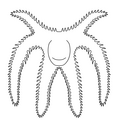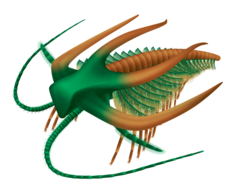Marrella
Marrella splendens is an arthropod known from the middle Cambrian Burgess Shale of British Columbia. It is the most common animal in the Burgess Shale.
| Marrella splendens | |
|---|---|

| |
| Fossil Marrella | |
| Scientific classification | |
| Kingdom: | |
| Phylum: | |
| Class: | |
| Order: | |
| Family: | Marrellidae Walcott, 1912
|
| Genus: | Marrella Walcott, 1912
|
| Species: | M. splendens
|
| Binomial name | |
| Marrella splendens Walcott, 1912
| |
History
Marrella was the first fossil collected by Charles Doolittle Walcott from the Burgess Shale, in 1909.[1] Walcott described Marrella informally as a "lace crab" and described it more formally as an odd trilobite. In 1971, Whittington did a thorough redescription of the animal. On the basis of its legs, gills, and head appendages, he decided that it was not a trilobite, nor a chelicerate, nor a crustacean.[2]
Marrella-like organisms are found in other Cambrian deposits. They are known from sediments as late as the Devonian.[3]
Marrella Media
References
- ↑ Gould, Stephen Jay (2000). Wonderful Life: Burgess Shale and the Nature of History. Vintage. p. 108. ISBN 978-0-09-927345-5. OCLC 45316756. Also OCLC 44058853.
- ↑ Whittington, H. B. (1971). "Redescription of Marrella splendens (Trilobitoidea) from the Burgess Shale, Middle Cambrian, British Columbia". Bulletin – Geological Survey of Canada. Geological Survey of Canada. 209: 1–24.
- ↑ Siveter D.J. et al 2007. A Silurian 'marrellomorph' arthropod (2007). "A Silurian 'marrellomorph' arthropod". Proc Biol Sci. 274 (1623): 2223–2229. doi:10.1098/rspb.2007.0712. PMC 2287322. PMID 17646139.






